This page is for personal, non-commercial use. You may order presentation ready copies to distribute to your colleagues, customers, or clients, by visiting https://www.parsintl.com/publication/autoblog/
As far as EVs go, the Ioniq 5 is easily one of our favorites. It looks stupendous, features great electric car tech, has tons of utility and is even pretty fun to drive. This tall hatchback rocks.
The 2022 Hyundai Ioniq 5 marks a new era for the Korean automaker, and based on how all-around fantastic this all-electric SUV is, we think it’s a sign of great things to come. Though technically a midsize crossover, it’s styled like a big hatchback – and a very retro futuristic one at that. And based on its performance, especially in the dual-motor all-wheel-drive version, this big hatch is hot.
In addition to its good looks (though its styling may be a little polarizing), the Ioniq 5 checks off the EV boxes with compelling performance, ample range and super-fast charging capabilities. It’s also quite comfortable and loaded with great infotainment and driver assistance tech. If you want an EV with a well-rounded combination of room, range, refinement and power, the Ioniq 5 is hard to beat – yes, even compared to the Tesla Model 3. If you need a little more ground clearance and rugged capability, you might want to check out the new Subaru Solterra, while the Ford Mustang Mach-E is a good choice from a performance perspective and if you’re not quite sold on the Ioniq 5’s looks. Ultimately, though, if you consider one other EV, it should be the Kia EV6, which is mechanically related to the Ioniq 5. Their EV credentials are very similar and they share many features. It looks completely different inside and out, however, and is probably less polarizing. It is also more widely available than the Hyundai.
The Hyundai Ioniq 5 is an all-new model for 2022. 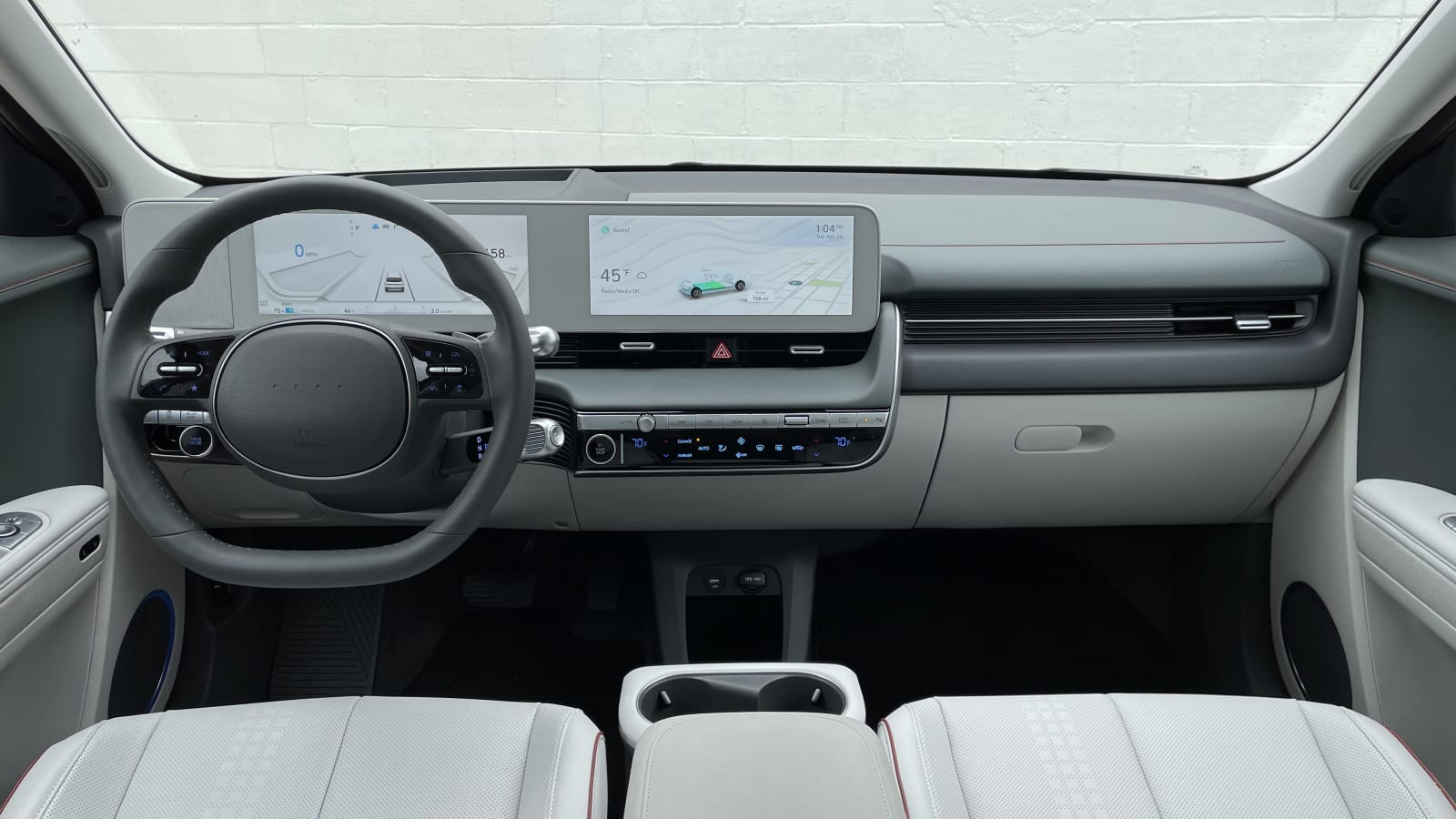
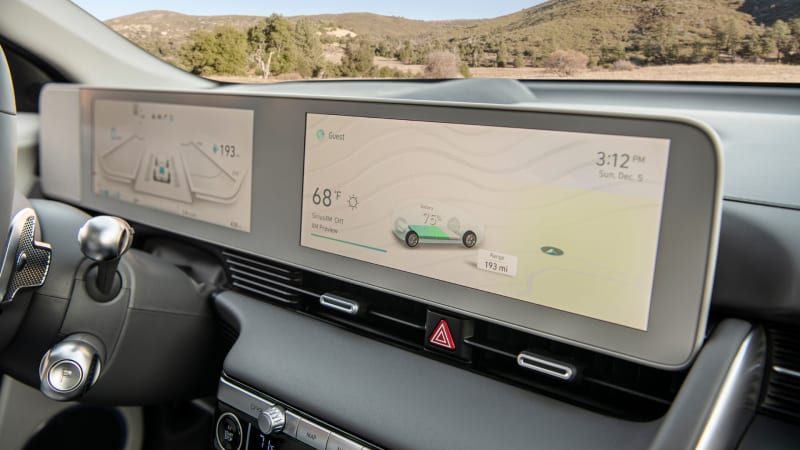
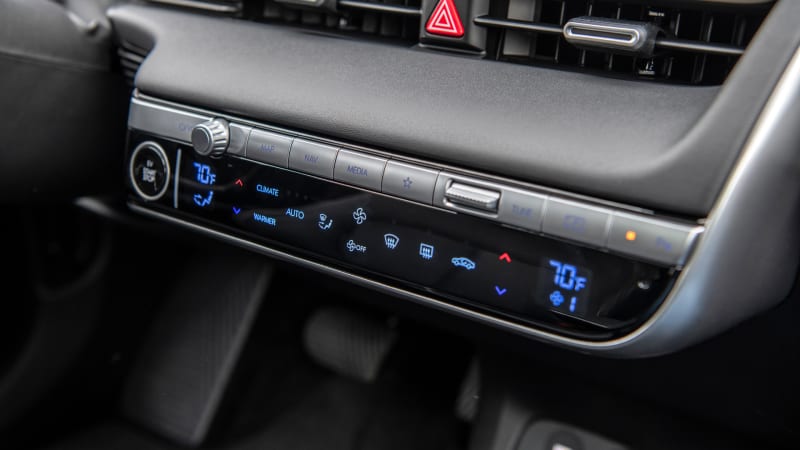
The Ioniq 5’s cabin is big, bright and airy, with a minimalist design aesthetic that doesn’t lose sight of functionality. Everything isn’t controlled and displayed on one screen, and there are still conventional buttons and switches for things like the windows and climate control where you expect them to be. Even the touch-sensitive buttons and electronic shifter, which are usually a source of frustration, are reasonably well-executed.
In the Limited trim, the center console is moveable, sliding forward and backward. That console is home to a pair of cupholders, a large cargo tray, a slot for a phone — with an available wireless charging pad — and a pair of USB ports. It’s a clean and calming space that’s surprisingly spacious and airy. The color palette is limited: black monotone and two-tone gray with a two-tone green only available with the Digital Teal or Shooting Star exterior on the SEL and Limited trim levels.
Every Ioniq 5 features dual 12.3-inch displays, with one serving as the instrument panel, the other as an infotainment touchscreen. It’s one of the better infotainment systems on the market. The menus make sense, simple tasks like changing a radio station are easy, responses are quick, and it looks good. We also like the 60/40-split screen functionality that lets you look at audio and navigation, for instance, at the same time. Wireless Apple CarPlay and Android Auto are not available, which obviously means you have to plug in your phone to use them. Unfortunately, the data USB port is under the dash down by your shin (below right), meaning your phone will end up stranded down there, too. The non-data USB ports and the available wireless charger are located in the center console (below left).
The Limited trim gets a head-up display with integrated augmented reality. In addition to the usual HUD duties, it can also project images to highlight the car ahead of you, give alerts about lane safety and help indicate where and when to make the next turn on your route. If that sounds like a lot of visual information, it is, but you can tailor the content shown in your HUD through menu selections. At present the only other cars out there with this type of technology are the Mercedes-Benz S-Class and EQS.
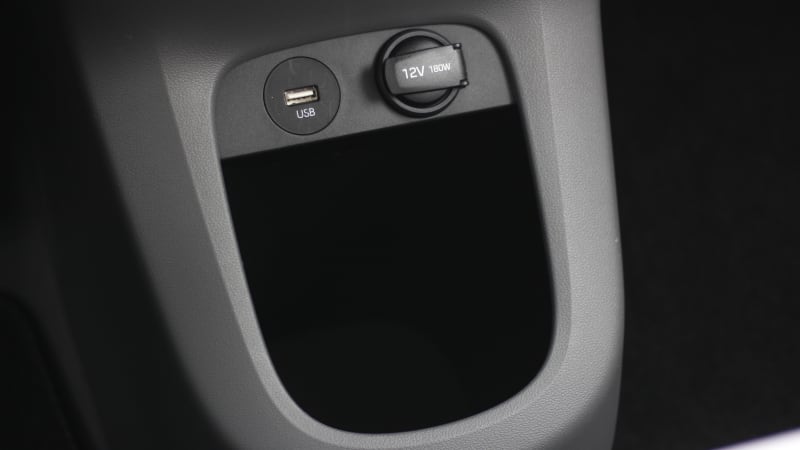
It’s way bigger than it looks. While it looks like a hatchback in photos, seeing it in person, you can better understand why the Ioniq 5 is better classified as a midsize crossover SUV. Its wheelbase is about 3 inches longer than that of the three-row Hyundai Palisade. As such, the Ioniq 5 is fabulously roomy inside. There’s tons of foot room for both front and rear passengers. The front row is very open, and the available sliding center console opens that lounge-like space up even more.
As for the cargo area, the footprint is big, but the aggressively raked rear window means taller items could impede the closure of the liftgate. The rear seats can slide forward to allow a little more luggage space, at the expense of second-row passenger space. The Ioniq 5 claims 27.2 cubic feet behind the second row, which is a slight disadvantage compared to the Ford Mustang Mach-E’s 29.7 and the Volkswagen ID.4’s 30.3. Max cargo space expands to 59.3 with the rear seats folded. It’s on-paper volume is greater than that of its Kia EV6 cousin, but in our Ioniq 5 Luggage Test, we found that the shape/slope of the hatchback impedes loading, shrinks usable size and ultimately makes the cargo less spacious than the EV6 and the other electric crossovers. There’s no front trunk (or “frunk,” if you prefer) under the hood apart from a small space (0.85 cubic feet) only big enough to stash the mobile charging cable or other small items. This is basically due to a packaging decision made when designing the Ioniq 5 to ensure the biggest passenger compartment possible. That’s a fair trade as far as we’re concerned. 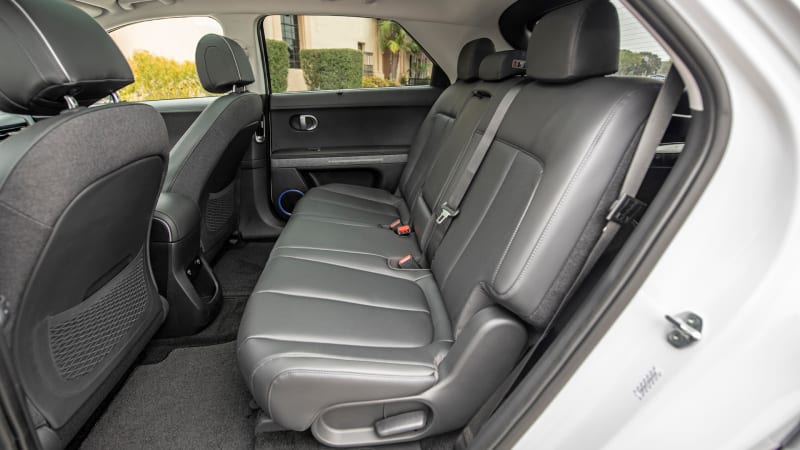
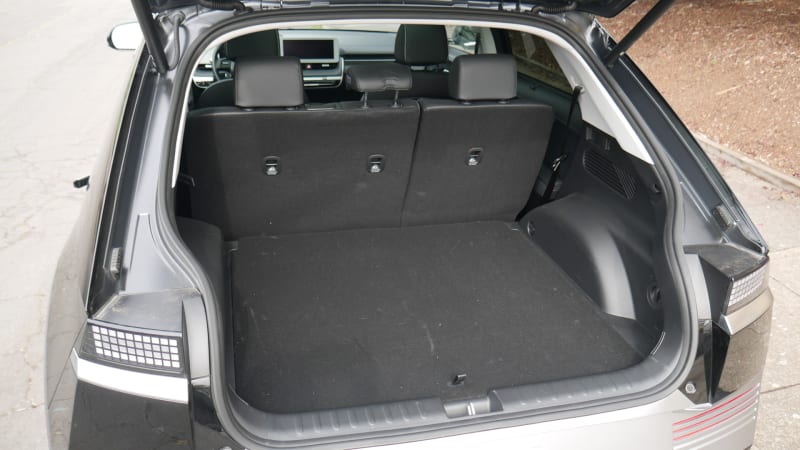
There are three drivetrain configurations for the Ioniq 5. The base standard-range version has a 58-kilowatt-hour battery good for 220 miles of driving. It is only available as a single-motor, rear-wheel-drive model with 168 horsepower and 248 pound-feet of torque. It’s rated at 127 miles-per-gallon-equivalent (mpg-e) in the city, 94 mpg-e highway, and 110 mpg-e combined
Then there are two versions with the 77.4-kWh long-range battery. The single-motor rear-wheel-drive version provides 225 hp and 258 lb-ft of torque. That’s good enough for a sprint from 0-62 mph in 7.3 seconds, which would be an average time for a midsize SUV. With a driving range of 303 miles, it’s rated at 132 mpg-e highway, 98 city and 114 combined.
The all-wheel-drive version’s dual-motor setup provides a total of 320 hp and 446 lb-ft of torque, which will motivate the Ioniq 5 from a stop to 62 mph in a rapid 5.1 seconds. That’s roughly the same as the comparable Kia EV6 and all-wheel-drive Mustang Mach-E. That extra power comes with a sacrifice in driving range, at 256 miles, and it’s rated at 110 mpg-e city, 87 mpg-e highway and 98 mpg-e combined.
On the charging front, the Ioniq 5’s 800-volt battery architecture means it can take advantage of 150- and 350-kW DC fast chargers, the latter able to take the battery from 10% up to 80% in just 18 minutes, which means you’ll spend a lot less time at the charging station than almost every other EV out there.
So far, we’ve only driven the all-wheel-drive version of the Ioniq 5, and it is an absolute delight. With all the headline-generating, eye-popping 0-60 times of ultra EVs like the Tesla Model S Plaid, it’s easy to forget that a 5-second 0-60 time is still awfully quick. The Ioniq 5’s instant torque is enough to snap you back into your seat as you rocket onto the freeway. With Sport mode engaged, the Ioniq 5 will treat you to a light but delectable serving of the rear wheels breaking traction to let the rear end peek out to say hello. It’s an addictive pleasure, and one that is sure to induce an endless supply of giggles.
That said, the Ioniq 5 can also be incredibly well behaved. Its long wheelbase makes for a calming sense of stability at highway speeds, while you’re quietly and comfortably whisked away to your destination. Hyundai’s Highway Driving Assist system includes adaptive cruise control (with machine learning to adapt to your driving style) and a very adept lane centering feature. The Highway Driving Assist II feature on the SEL and Limited trims gets semi-automated lane changes and integration with the AR HUD. There are also driving modes — Normal, Eco, Sport and Snow — to fit your mood or situation, and you can also dial in different amounts of regenerative braking force using the paddles on the back of the steering wheel.
This is our first crack at the Ioniq 5, and we drive the top trim level with all-wheel drive in the city, on the highway and through some winding mountain roads. Let’s just say we’re in love.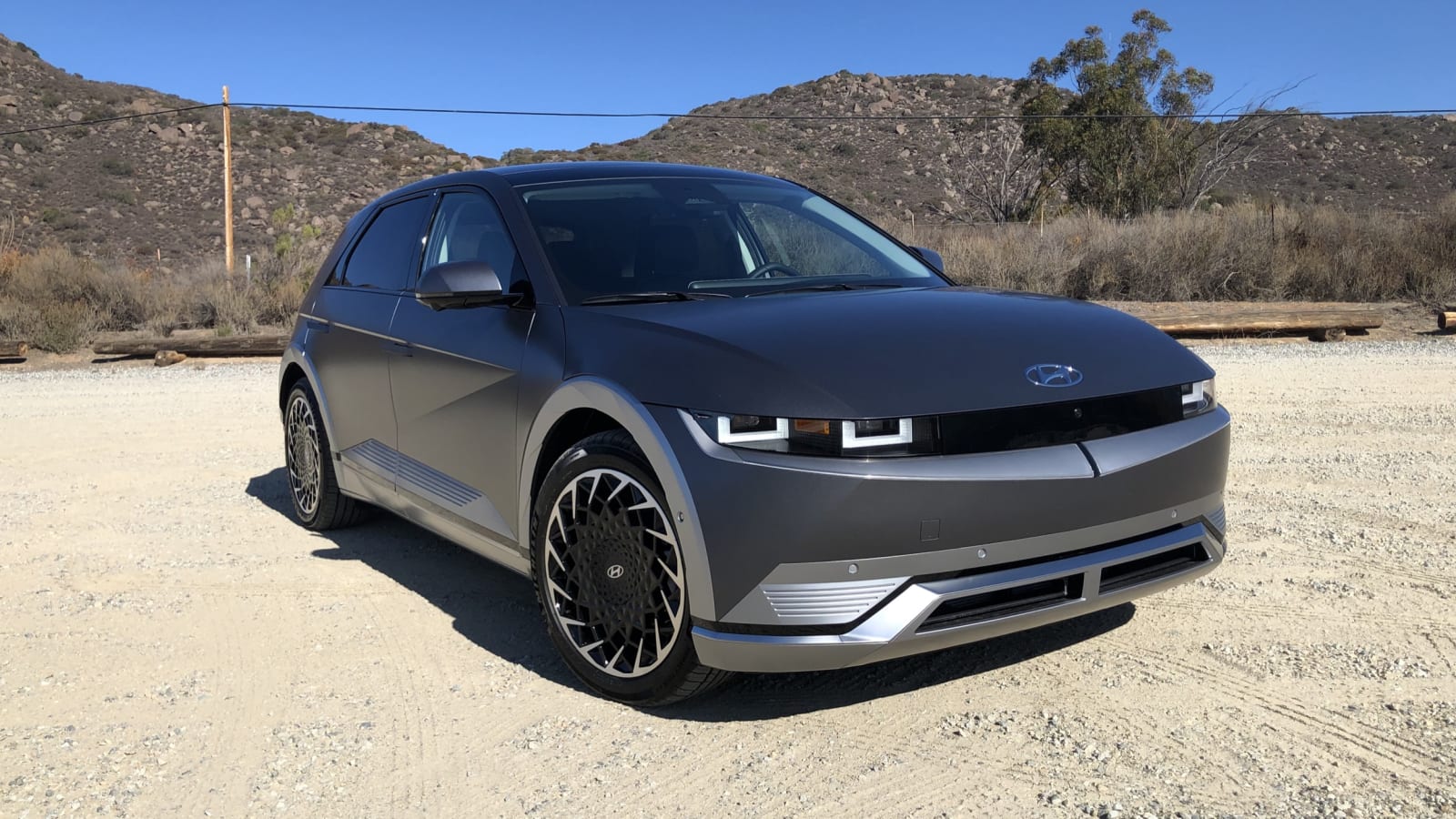
Autoblog Podcast #710
In this episode of our weekly podcast, we talk about driving the Ioniq 5, among other things.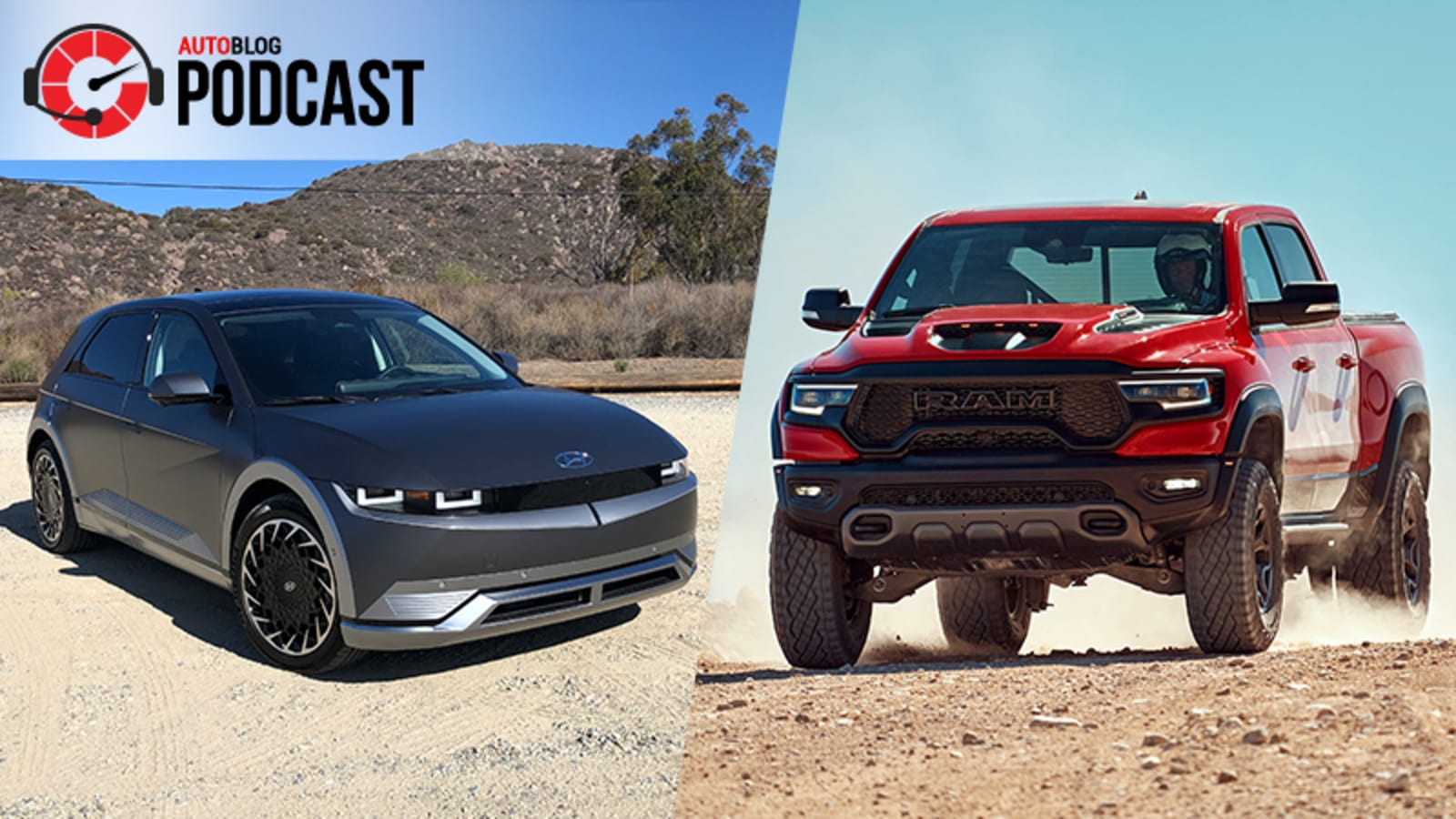
The Ioniq 5 starts at $40,945, including destination but before incentives, for the standard-range, rear-drive SE. Long-range versions start at $44,895 for the SE RWD or $48,395 for the SE AWD. The SE trim includes 19-inch wheels, LED lighting, heated mirrors, dual-zone automatic climate control, proximity entry and push-button start, cloth seats, eight-way power driver’s seat, heated front seats, 12.3-inch digital instrument cluster, and 12.3-inch color touchscreen infotainment with voice recognition, wired Apple CarPlay and Android Auto.
Also available in higher trims are 20-inch wheels, LED projector headlights, premium LED accent lighting, power folding mirrors, rain-sensing windshield wipers, hands-free liftgate, leatherette seats, eight-way power passenger seat, ventilated front seats, heated steering wheel, a driver’s seat relaxation footrest (an appreciated feature for waiting around for your car to charge), Bose audio system, augmented reality head-up display, wireless phone charger, sliding center console, second-row AC vents, remote parking assist, rear side-window sunshades, vehicle-to-load charger, 64-color ambient lighting, surround-view parking camera, blind-spot view monitor, Highway Driving Assist II with automated lane changes and the ability to use your phone as a digital key.
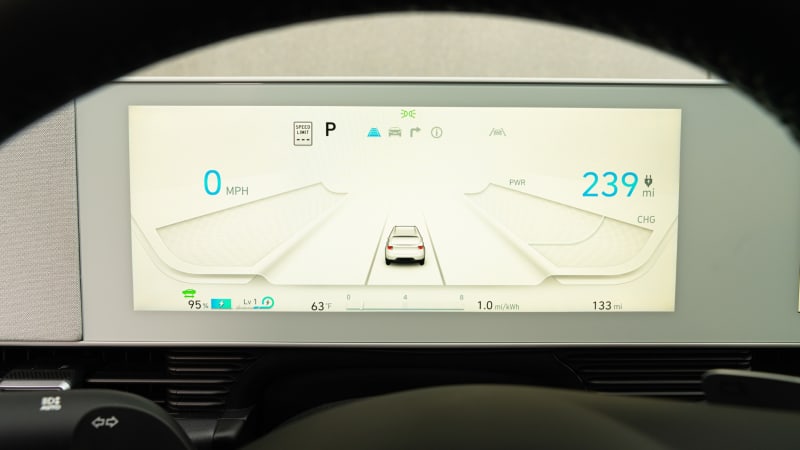
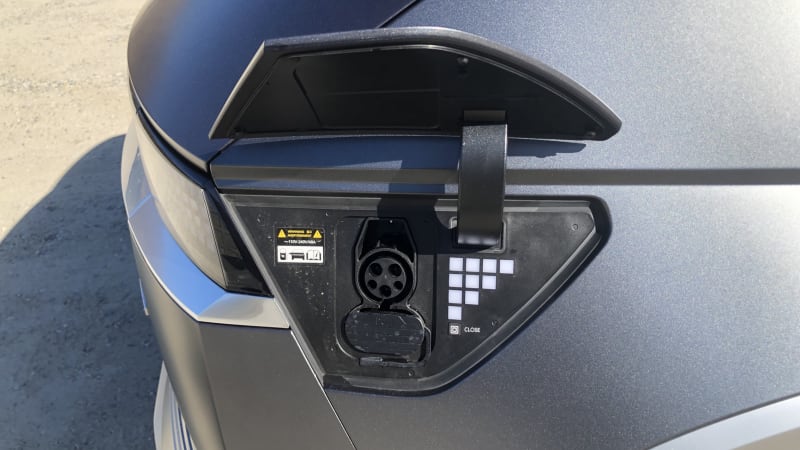
Every Ioniq 5 comes standard with forward automatic emergency braking with pedestrian and cyclist detection, lane-keeping assist, blind-spot and rear cross-traffic warning, Safe Exit Assist (uses the last two items to warn you against opening doors into cars or bicycles), a driver inattention warning system, rear occupant alert, rear parking sensors and adaptive cruise control with stop-and-go functionality and lane-centering steering assist. Also available are surround-view parking camera, blind spot view monitor, front parking sensors, as well as the added functionality of Highway Driving Assist II (automated lane changes, and improved logic for adaptive cruise control to better adjust to cars cutting in front of you or encroaching on your lane). Besides simply having all these driver assistance features, it’s important to note how well-executed they are.
The Hyundai Ioniq 5 has not yet received crash test and safety ratings from NHTSA or IIHS.
Related video:
Autoblog accepts vehicle loans from auto manufacturers with a tank of gas and sometimes insurance for the purpose of evaluation and editorial content. Like most of the auto news industry, we also sometimes accept travel, lodging and event access for vehicle drive and news coverage opportunities. Our opinions and criticism remain our own — we do not accept sponsored editorial.
Please sign in to leave a comment.
GM to offer U.S. Buick dealers buyouts
The next big battery material squeeze is old batteries
Next-gen Ford Mustang hybrid and AWD reportedly dead
New Ford Bronco or Vintage? Now you don’t have to choose
2023 Jeep Gladiator gets special edition trim and colors
Junkyard Gem: 1993 UMC Aeromate Food Truck
News, Reviews, Photos, Videos
delivered straight to your in-box.
Thanks for subscribing.
Check your in-box to get started.
More Info
You must be logged in to perform that action.
Please enter a display name
